Upward momentum shifted into overdrive based on the mere fact that the U.S. government is no longer shut down. Never mind that none of the real issues were resolved—the proverbial can has been merely kicked down the road again.
It did not matter to the markets, which simply took off with the S&P 500 gaining some 3.4% since last week’s ETF Model Portfolio report was issued.
We’re back to the same theme we’ve had all year in that mediocre news, like yesterday’s non-farm payroll report, are a good thing as it simply means that the overhanging “taper” may be postponed once again confirming that the economy is unable to organically grow on its own.
Be that as it may, there is a price to be paid at some point when market participants realize that this rally is supported by nothing than hot air. When the eventual turnaround occurs, it pays to be prepared via an exit strategy such as our sell stop discipline.
In the meantime, here’s the latest ETF Model Portfolio update:
1. ETF Trend Tracking Model Portfolio
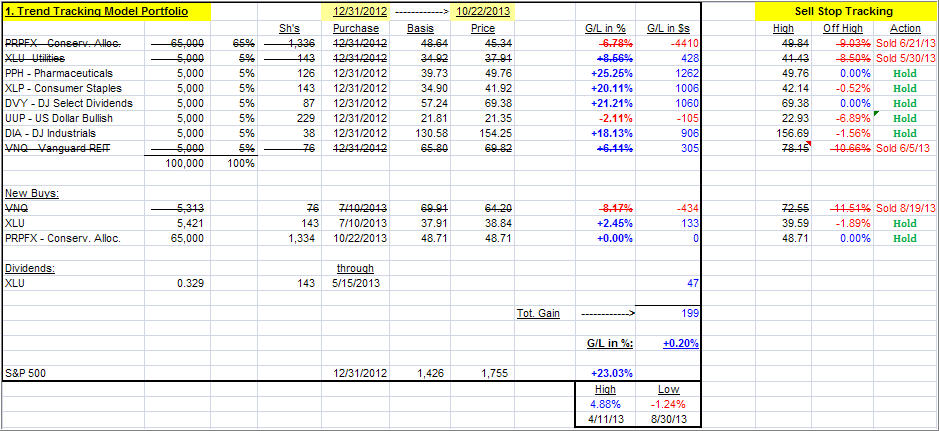 [Click on any table to enlarge]
[Click on any table to enlarge]
This is the portfolio allocation I have used predominantly in my advisor practice during the first half of 2011, although it lagged in 2012 and 2013 with PRPFX being the culprit due to the Fed’s relentless money pumping efforts that are having a more positive effect on equity and sector ETFs—that is until the bubble bursts.
Around the PRPFX fund, when in buy mode, I add what I call boost components consisting of ETFs that can produce higher returns than my core holding, at least during bullish periods. When a market pullback occurs, the core holding should add an element of stability.
Nevertheless, as you know from my writings, anything I invest in involves the use of trailing sell stops, which are shown and tracked on the upper right of the table.
2. Conservative ETF Growth Portfolio
This portfolio, as are the following ones, would be typical of what is being used in the buy-and-hold community, as you can see by the 40% allocation to various bond ETFs. If you are conservative, this simple combination could work for you, but I still recommend the use of the trailing sell stops during these uncertain times.
3. Aggressive ETF Growth Portfolio
What makes this one aggressive is the small 15% allocation to bonds. If you have an aggressive streak in your personality, you could consider this one. If you use my recommended sell stop discipline, you know exactly ahead of time what your downside risk will be.
4. Moderate ETF Growth Portfolio
I call this one moderate growth, because of the higher allocation to various bond ETFs (27%) than in the aggressive set up above. It is also more diversified domestically.
5. ETF Income Portfolio
This is as simple as it gets, but this model held up well in 2012 and turned out to be the top performer out of the seven I feature. Only two ETFs were stopped out during the past year, and the proceeds were subsequently re-invested as the upward trend emerged again.
6. ETF Bond Portfolio
Many readers have asked for an ETF Bond portfolio, which I have set up in this section; it replaces the old Ivy Portfolio.
With the global slowdown underway, bonds continue to have upside potential until higher interest rates caused by inflationary tendencies will bring this rally to an end. Fed policy is promoting lower rates for another couple of years or so, but market pressures due to unintended consequences could bring this trend to a sudden end, which is why the use of my recommended sell stops is critical.
Even though this is a bond portfolio, I believe some small equity exposure (DVY) is vital should the relentless pumping of equities continue.
7. The ETF Equivalent of PRPFX
As posted recently, I have created and back tested the ETF equivalent of my favorite mutual fund, PRPFX, which is a core holding in my #1 Portfolio. If you missed it, you can read the announcement here.
Take a look at the combination of ETFs:
Since these 8 ETFs represent only one fund, namely PRPFX, we can apply a different exit strategy. For that purpose, I will not track the high points made for each ETF, as with the other 6 models, but measure my 7% drop from the high point this entire portfolio has made.
Alternatively, you can sell this entire portfolio once our domestic TTI has crossed into bear market territory or hold on to only those positions that are maintaining upward momentum. That solves the issue of “what to buy” if you had liquidated 100%.
As posted recently, since PRPFX has drifted into bear market territory, this ETF equivalent has been closed out as well. Should PRPFX move back on the bullish side of the trend line, I suggest you look at PERM as a viable alternative (no holdings) if you prefer using ETFs.
(ETF trading costs are not included in these portfolios demonstrations. They are intended to show market effects on different scenarios only as an educational tool)
To repeat, the key to selecting a portfolio from the above list is not just performance. Personally, I’d rather lag a little on the upside but have some assurance that I will also lag when the downside comes into play.
I will update these portfolios every Wednesday.
Quick Reference:
Disclosure: I may have personal and/or client holdings in some of the funds/ETFs discussed above
Contact Ulli
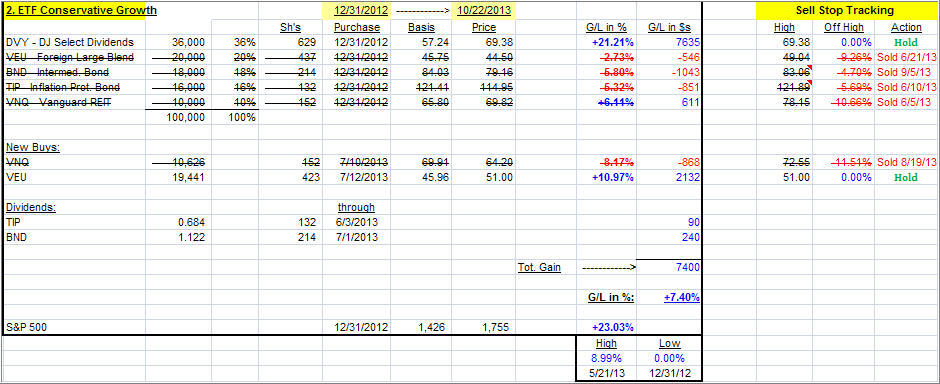
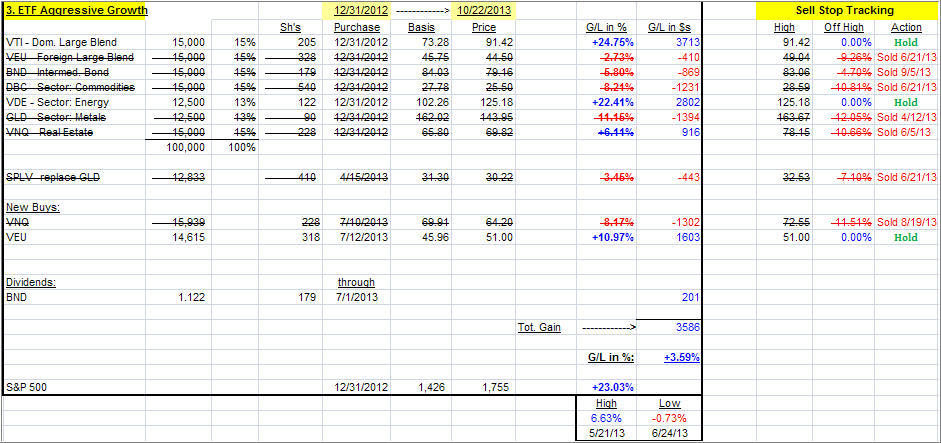
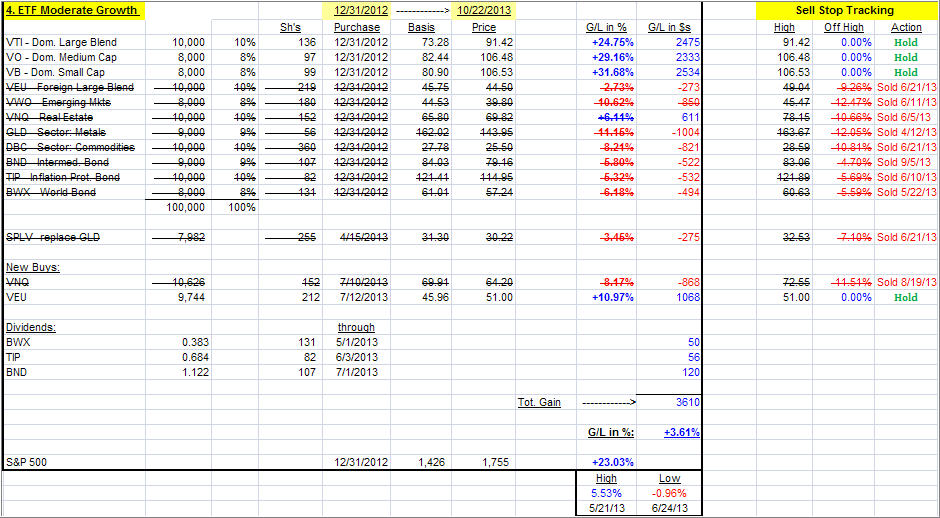
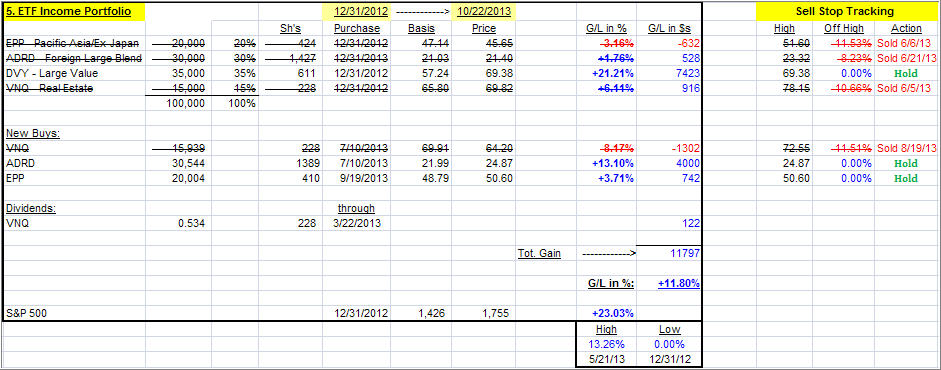
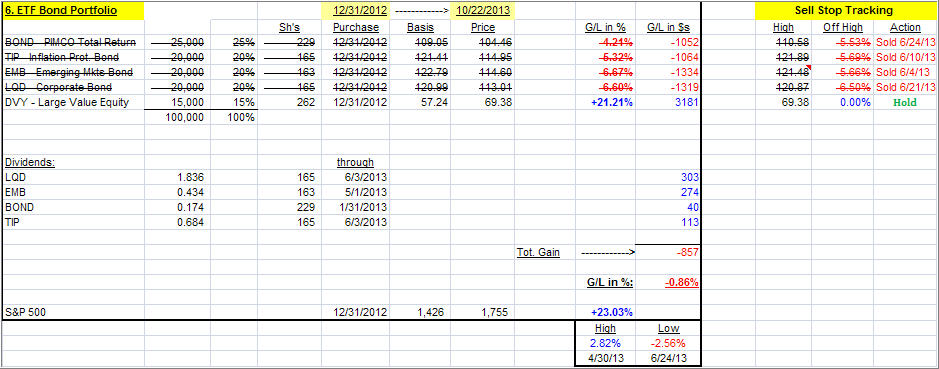
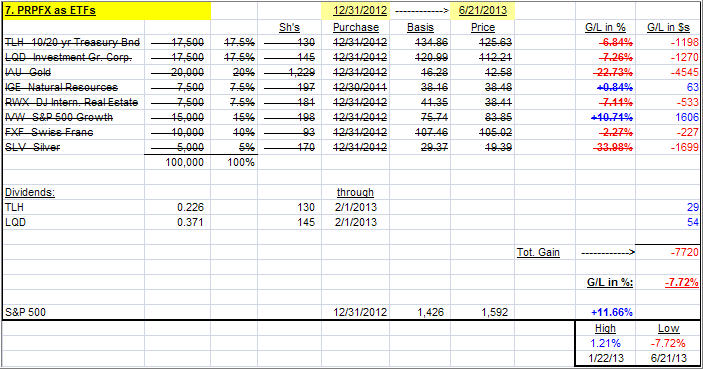
Comments 2
Ulli, I have been following your commentary on the market for several months and I find it enlightening and valuable. But as I review your model portfolios shown above I perceive the that your “sell stop” strategy does provide a good protection against major market declines. However your rules of when to buy back into the market are clearly deficient as shown in your results for the YTD. I admit that the May drop scared me into going into 15% cash. You went deep into cash. But I saw rebounds happening and bought back in – too slowly but I did. Your portfolios generally missed a huge market advance due to your rules. [The advance may have no fundamental basis but ….] I suggest you rethink your “buy back in strategies” because, certainly this year, they have cost you a bundle vs. someone who just bought SPY and held it and made 23% YTD. Perhaps you should consider 50 and 25 day moving averages as well as 200 day ones. There are physics-type models which may be helpful but are not appropriate to discuss here. Happy to discuss further.
Kevino,
Thanks for your comments. As I posted before, the bond holdings proved to be a drag on model portfolio performance. To stay true with the models, I did not make any substitute investments as I did in my advisor practice. It definitely was the year of equities, as we look at it with the benefit of hindsight. That is also demonstrated by the results of Model #5, the only one that did not contain bond ETFs.